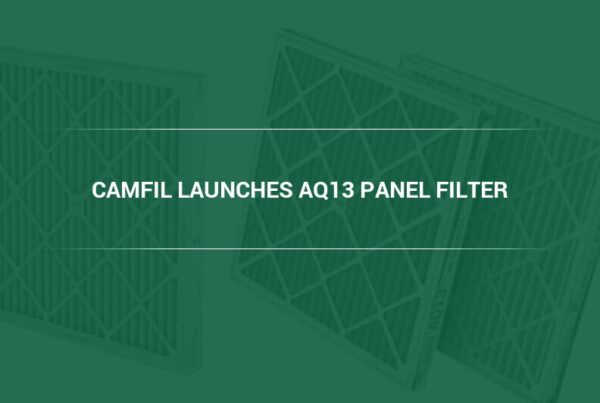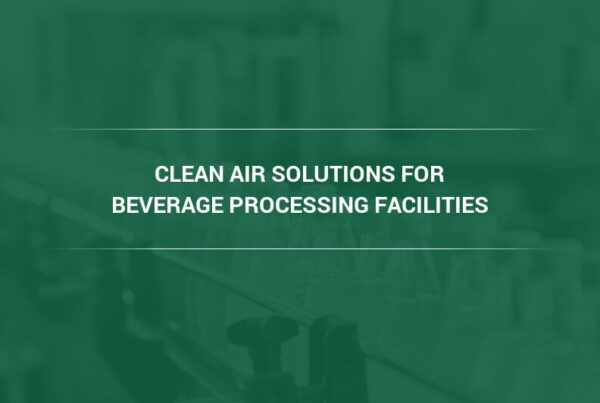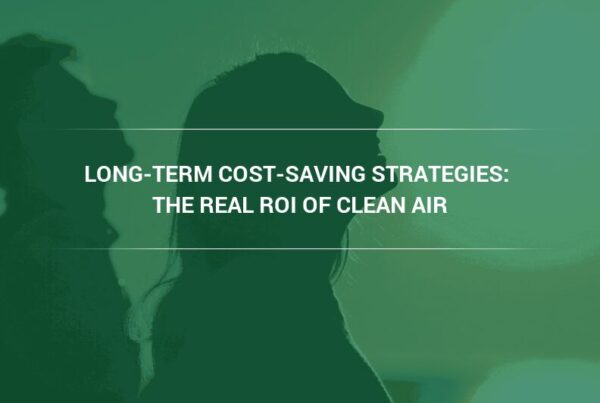International airports that handle millions of passengers each year deal with major air quality issues from both outdoor and indoor sources. Aircraft are the main source of outdoor airport pollution. When planes land, taxi, or take off, they release gases, volatile organic compounds (VOCs) and fine particulate matter into the air. These exhaust plumes can drift into terminal air intakes or open doors, letting pollutants enter the building and harm airport indoor air quality.
READ: How Airports Are Using High Efficiency Filters to Lower Air Pollution
Ground support equipment, like fuel trucks and baggage tugs, adds to the mix while traffic around the airport, including cars, shuttles and buses, adds more emissions that can enter terminal entrances and ventilation systems. In crowded terminals, CO2 and VOC levels rise, sometimes exceeding recommended levels (>1000 ppm), which makes the air feel heavy and low in oxygen.
All these factors combine into a complex air quality problem. Addressing it requires coordinated efforts to reduce emissions and improve ventilation. Effective airport pollution control is important not only for protecting health but also for maintaining operational efficiency and safeguarding your airport’s reputation.
This article examines air quality challenges faced by airports, exploring the costs to health and reputation, priority areas for improvement, and effective ventilation and airport air filtration strategies that create cleaner, healthier indoor environments.
Why Airport Air Quality Presents Unique Challenges
The Perfect Storm of Outdoor Pollutants
Airport pollution comes from multiple sources:
- Jet exhaust: Aircraft engines emit nitrogen oxides (NOx), carbon dioxide (CO2), carbon monoxide (CO), VOCs, particulate matter, as well as black carbon from incomplete combustion.
- Ground support equipment: Diesel-powered airport vehicles contribute additional emissions.
- Surface traffic: Cars, buses and shuttles release CO2, NOx, VOCs and particulate matter around terminals
- Construction and expansion projects: Heavy machinery and construction activities generate dust and particulate matter.
- Passengers: High occupancy elevates CO2 and VOC levels indoors.
The combination of these sources produces a dynamic air quality challenge. Elevated levels of particulate matter, black carbon, CO₂, and other gaseous pollutants affect both passenger comfort and staff health.
How Outdoor Air Sneaks Inside Terminal Buildings
Terminals rely on HVAC systems to bring in fresh air. If that air contains pollutants, it can worsen indoor air quality if proper airport air filtration is not in place. Fine and ultrafine particles (PM 1, PM2.5, black carbon) and gases such as NOx, CO and VOCs can bypass standard filters and accumulate indoors, especially in busy areas with limited ventilation
You might expect that increasing air exchange rates would improve airport indoor air quality by diluting pollutants. However, if the outdoor air is polluted, pumping more of it indoors can increase indoor pollutant concentrations. Dilution is not always enough to remove harmful outdoor particles unless the ventilation system has high-efficiency filters.
Additionally, air pressure differences between the inside of your terminal and the surrounding outdoor environment can unintentionally pull polluted outdoor air into the building, further increasing indoor pollutant concentrations.
To effectively manage air quality in airport terminals, you need to ensure high-efficiency filtration, careful control of air exchange rates and monitoring of pressure differences to minimize the impact of outdoor pollutants.
The Human Factor: Thousands of People, Constant Movement
As you move through the airport terminal, your presence and other passengers directly influence the airport’s indoor air quality. Changes in occupancy, ventilation effectiveness and pollutant sources all affect the air you breathe at different points in your journey.
- Check-in/Bag drop: Here, you gather among other travelers for extended periods. Long waits and dense crowds elevate CO2 and VOC concentrations from human respiration.
- Security screening: In this crowded area, you often stand close to others and move slowly through checkpoints. These conditions increase CO2 concentrations and higher bioaerosol levels.
- Departure lounges: As you sit or move intermittently while waiting for boarding, CO2 levels vary depending on how many passengers are nearby. Occupancy density determines whether air quality remains moderate or becomes poor.
- Baggage claim: When you arrive, you and other passengers cluster around carousels, creating localized zones of high occupancy and consequently elevated CO2 levels.
- Ground Transportation: As you leave the terminal, opened doors allow vehicle exhaust to seep indoors.
What Poor Air Quality Actually Costs Airports
The Health Toll on Employees and Travelers
Your comfort and overall travel experience can decline when airport indoor air quality in the terminal is poor. Inadequate ventilation can lead to a buildup of CO2 and VOCs, causing fatigue, eye or throat irritations and general discomfort among passengers and airport staff. Even short-term exposure to elevated CO levels can make you feel dizzy or give you headaches.
If you have a pre-existing respiratory condition, such as asthma or chronic obstructive pulmonary disease, you are particularly vulnerable to fine particulate matter (PM 1 and PM2.5) and NOx exposure, which can trigger breathing difficulties and airway inflammation. Studies show that airport workers and frequent travelers are exposed to higher levels of these harmful particles than the general population, raising their long-term risk of lung disease and heart problems.
Workers stationed near taxiways, fuel stations and other high-emission areas frequently face long-term exposure to NO2 and SO2, which are linked to lung inflammation and long-term pulmonary damage. Elevated CO and NO2 concentrations may also reduce concentration and reaction times, potentially compromising safety-critical tasks.
Brand Reputation and Passenger Experience
Air quality is closely tied to airport brand reputation as it affects passenger comfort, health and the overall experience. Since the COVID-19 pandemic, clean air has become a major factor that sets airports apart. As you prioritize your health, safety and well-being more than ever, the freshness and cleanliness of the air serve as clear signs of how much an airport values your care. Failure to meet these expectations can damage your perceptions of an airport’s quality and reliability.
When you move through clean, well-ventilated spaces, your travel experience is higher. Airports that maintain high air quality standards receive higher ratings for comfort, cleanliness and experience. This, in turn, fosters passenger loyalty, as travelers are more likely to return or recommend airports that prioritize their health and comfort.
Operational Expenses and Community Relations
Poor air quality in airports can increase operational costs in several ways:
- You face higher maintenance costs: When your airport HVAC systems are dirty, they require more frequent cleaning, filter changes and repairs to manage pollutants and maintain air circulation.
- You use more energy: Poor air circulation often forces your HVAC systems to work harder, raising electricity and fuel costs. Fans must work harder to push air through clogged filters, which can increase electricity consumption by up to 30 percent while fouled coils can increase total system energy use by 10–20 percent.
- You risk compliance penalties: If your airport fails to meet airport indoor air quality standards, you may face fines or regulatory actions that can become costly.
- You shorten equipment lifespan: Dust, dirt and particulate buildup add strain to motors, compressors and other components of airport HVAC systems, forcing you to replace equipment sooner than expected.
Beyond operational costs, poor air quality can damage your airport’s reputation. It signals a lack of commitment to passenger health and safety, weakens community support and attracts negative media attention or scrutiny from regulatory agencies and advocacy groups. These factors can downgrade an airport’s reputation and compromise long-term brand loyalty.
Where Airports Need Air Filtration Most
You need to recognize that different areas of your airport require different levels of filtration. To maintain clean and healthy air, you must tailor airport air filtration systems to each area’s function, occupancy and exposure to pollutants.
At check-in areas, where doors constantly open as passengers enter and exit, and where HVAC systems run nearly continuously, you should consider a minimum efficiency of MERV 13A if the system is capable of holding a filter at least 6 inches deep, but at least 12 inches are preferable. For systems capable of holding only 1, 2 or 4 inch deep filters, the minimum efficiency should be MERV 13/11A. Filters of these efficiencies will capture a high enough percentage of fine particles to improve air quality inside the terminal.
In security screening and custom zones with a high density of passengers and long waits and based upon the configuration of the HVAC systems, you should upgrade to filters rated MERV 14A-16A to maintain clean air and minimize transmission of airborne contaminants.
At departure gates and boarding areas where passengers are often exposed to outdoor air from jet bridges and tarmacs, consider air filters with a combination of particulate filtration for PM1 and PM2.5 particles and with molecular filtration capabilities. These dual-purpose filters are ideal in these areas as they target both particles and the gaseous pollutants common in these areas. Likewise, in lounges and food courts challenged with cooking emissions, odors and VOCs, these combinations of particulate and molecular filters can improve air quality.
For baggage handling and maintenance, the HVAC systems supplying air to these areas often dictate air filter selection. Where possible, MERV 13A or higher is a better choice, but size restrictions may limit filters to 1, 2 or 4 inch depths, and if so, MERV 13/11A pleated filters are recommended. Finally, HVAC systems supplying air to ground transportation areas exposed to high concentrations of vehicle exhaust are ideal candidates for combination particulate and molecular air filters to capture fine particles, soot, odors and gaseous pollutants.
Staff Areas
In aircraft hangars where staff are exposed to jet exhaust and chemical vapors during aircraft servicing and fueling, it’s recommended you work with a local air filtration professional with molecular filtration experience. They can determine the ideal solutions based on the concentration of contaminants in the air. Dedicated molecular air filtration systems may be required, such as units with cylinders capable of holding larger quantities of carbon media.
For back-of-house areas, including administrative offices and break rooms, you are mainly exposed to standard indoor pollutants such as dust, fiber, and biological contaminants. Here again, depending on the configuration of the HVAC systems, air filters with a minimum efficiency of MERV 13/11A up to MERV 16A will maintain a healthier workspace.
Particulate Filtration: Stopping What You Can See (and What You Can’t)
Understanding Filter Efficiency Ratings for Airport Applications
At the heart of every HVAC system is the filter that captures and removes particulate matter from the air. Choosing the correct filter is essential to effectively remove specific dust compositions from your environment. MERV ratings help you select the appropriate filter for your industrial dust collection system.
HEPA filters exceed MERV ratings with a minimum efficiency of 99.7 percent on airborne particles as small as 0.3 microns. You should consider using them to remove very fine submicron particulates and in systems capable of one or two stages of prefiltration to protect them and extend service life.
Airports have diverse environments, from terminal lobbies to baggage handling areas and aircraft maintenance hangars, so your filtration needs vary widely. A MERV 13 air filter is typically used to control particles generated from combustion exhausts, construction, maintenance and the terminal occupants.
MERV 11 to 13 filters are ideal for baggage handling and back-of-house areas with moderate particle levels from dust and equipment. Ground transportation zones are also best served with MERV 8 to 13 filters as well as activated carbon filters.
When selecting MERV-rated air filters for airport areas, it’s important to match the filter performance to the specific zone type, airborne contaminant levels, and occupancy.
Camfil Solutions for Particulate Control
Airports expose you to a complex mix of contaminants, so you need a layered airport air filtration approach to maintain comfort, safety, and compliance with indoor air quality standards. Each Camfil filter type serves a distinct role at specific stages of your airport HVAC systems to ensure reliable air quality.
Camfil’s AQ13: This is ideally suited for single-stage HVAC systems configured to hold filters of 1, 2 or 4 inch in depth. This filter is compliant with ASHRAE 241 with exceptional strength for long service life.
Hi-Flo ES: Positioned as a standalone air filter or in the second stage of an air handling unit, the filter captures both large particles and submicron-sized particles. A deep-pleated design enhances dust-holding capacity. You can select units with MERV 11A to 15A for tailored efficiency and in depths ranging from 12 to 30 inches.
Durafil ES3 & Compac: These high-efficiency final filters feature extended surface areas and V-bank designs for low resistance, long-service life and consistent performance. They excel at removing fine dust, soot and smoke generated by jet exhaust, ground vehicle emissions and heavy passenger activity. You’ll find these long-life filters are valuable in large airport HVAC systems where filter change-outs are difficult or costly.
Absolute VG: Where HEPA filtration is desired, use these compact, very lightweight, box-type filters to remove ultrafine particles in ensuring a contaminant-free environment. They are ideal for sensitive areas such as control towers and security zones requiring cleanroom-level air quality.
Molecular Filtration: Addressing Gases and Odors
When Particulate Filters Aren’t Enough
Particle filters are not enough for you to capture gases, vapors or molecular-level contaminants such as ozone, NOx, VOCs and basic gases. You need molecular filtration, which targets molecules rather than particles, to remove unpleasant odors from food courts and restrooms and reduce exposure to chemical vapors generated from jet and ground vehicles. Using these filters helps you create cleaner, safer areas for passengers and staff, protects electronic equipment in control rooms and IT centers and ensures you meet IAQ and environmental regulations.
Activated carbon is the most common filter medium for molecular filtration because it has a large surface area and absorbs molecules from the air. You typically combine them with high-efficiency air filters to remove dust, pollen and particulate matter.
Camfil’s Molecular Filtration Products
Camfil molecular filtration products are widely used in airport air filtration to capture a variety of particulate and gas contaminants. Key lines include:
| Product Line | Description | Airport Use |
| CityPleat | Compact 2-in-1 panel filter combining particle and molecular filtration in one filter stage. | Designed for low concentration gas zones such as public lounges and offices and retrofit applications. |
| CityCarb | Combination V-bank air filter with MERV15 particulate and molecular media removes solid and gaseous contaminants in one filter stage. This compact filter is used in fresh air make-up systems to control external pollutants. | Terminal zones with moderate levels of gaseous contamination and the desire for a compact, integrated filter. |
| Cylinders | Cylindrical carbon filters offer heavy to medium filtration of VOCs, odors and exhaust gases. | Airport zones with high molecular pollutant loads such as near gates and baggage handling. |
| AirImage COR | Real-time monitoring system measures the corrosivity levels of the environment. | Helps airports track pollutant levels and optimize filter use. |
Taking Action: What Airport Managers Should Do
To understand the state of airport air quality, you should conduct an air quality audit to measure particulate matter, VOCs and other pollutants across terminals, lounges, gates and other areas.
Next, you should review filter specifications and change-out schedules. Check the type, efficiency and placement of your HVAC filters and ensure that they are being replaced according to manufacturer recommendations to maintain peak performance. Monitoring pressure drops across filters to gain insight into system performance and filter loading to spot filters needing attention.
It’s best to engage an airport air filtration expert, such as Camfil, to specify the best solutions for optimizing both particulate and molecular purification in your airport environments. By treating air quality as an infrastructure asset instead of just maintenance, and using life-cycle modeling, monitoring and continuous improvement, you can shift from reactive maintenance to proactive health protection.
By prioritizing air quality, you position your airport as a community health asset. Clean, well-filtered air not only enhances the passenger experience but also protects everyone in your facility and strengthens your airport’s reputation as a leader in public health and safety.
Contact us to learn more about our full range of solutions tailored for airport air filtration solutions to help you control particulate and molecular pollutants.



